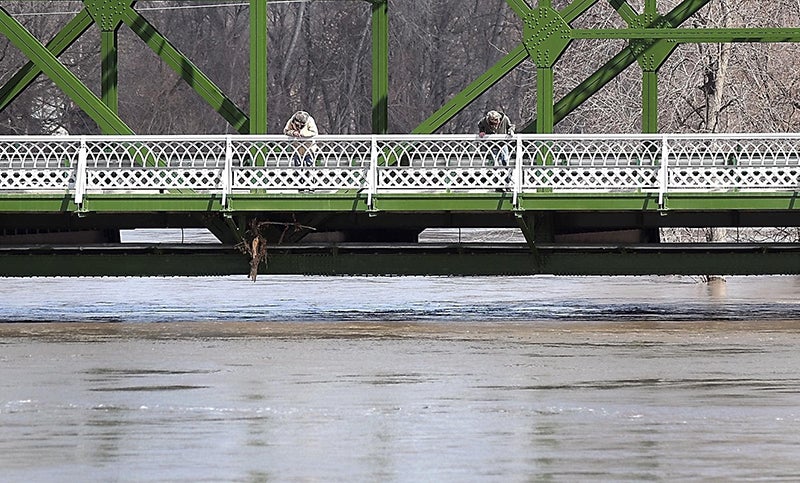So you think your home might flood?
Published 9:29 pm Thursday, March 21, 2019

- Two men look at a raging Minnesota River beneath the Highway 99 bridge Wednesday in St. Peter. - Pat Christman/Mankato Free Press via MPR News
Do this stuff now
By Cody Nelson, Minnesota Public Radio News
Flood preparation is one of those things that ends up on the backburner until it’s too late.
Lori Hendrickson with the University of Minnesota Extension gets it. “People are awfully busy in their daily lives so they tend not to think about these things or maybe they don’t want to be thinking about them,” the family resiliency professor and educator said.
But even when flooding is out of sight and mind, getting ready for what could come can mean the difference between a manageable and catastrophic crisis.
Here are some ways to make sure your home, family and pets are prepared, as much as possible, for the worst of flood season:
Get your documents in order
• Check on your insurance: Flood insurance isn’t always as straightforward as we may like. Hendrickson suggests checking with your agent to make sure you understand what your policy does and doesn’t cover.
• Make a “grab and go” file: Hendrickson says people should collect all documents that are impossible or difficult to replace and secure them in a waterproof container that you can keep with you if evacuation becomes necessary. That includes marriage, birth and death certificates, divorce decrees, health care directives, insurance information, Social Security cards, bank and insurance information — anything important.
Brace your home for the worst
The state Department of Public Safety (DPS) has a checklist of ways to prepare your home for flooding by focusing on a few key areas:
• Raise your water heater, appliances: Groundwater levels can increase and seep through a home’s foundation. To prepare, DPS suggests installing blocking to raise crucial, costly items like appliances, furnaces and water heaters off the floor.
• Stop sewage backup: If a sewer backs up, the flood or blockage can affect homes far away. DPS suggests calling a plumber to install a valve where the sewer main leaves your house to stop sewage from going the wrong way, into your home. Plugs are also a temporary fix for sewage drains.
• Check your sump pump: Spring runoff or minor flooding can stress a sump pump system, so DHS advises checking the ejection pipe, sump and sump pump to make sure they’re working properly. The department also says a spare sump pump and generator can be helpful in case the flooding lasts a while or power goes out.
• Shut off your utilities before the flood: That includes water, gas and electric. And keep them off, too — DHS says utilities may require a professional to restore service.
• If you have a well, close it off: DPS says people with wells should put a tight, waterproof cap on them, and then wrap the cap and well casing with sheet plastic and duct tape. Then, place sandbags around the well and set up backflow prevention wells. Make sure you have some clean drinking water safely stored away, too.
Conduct a home inventory
In case you need to make an insurance claim, having documentation of your belongings and condition of structures in your home can be crucial.
Creating such documentation, Hendrickson said, can be as simple as taking a video on your phone for each room in the house, explaining the age and model of expensive items you’d want help replacing after a flood, like a fridge.
Save whatever money you can
Saving up even $400 or $500 can make a big difference after disaster, Hendrickson said. And if you’re not in a place to save funds, she suggested using a credit card to help cover emergency expenses after a flood.
For example, some money to buy a dehumidifier can help save your home from mold accumulating after a flood.
If you might need extra help, make a plan
Evacuating a flood zone is extra difficult for the elderly and people with disabilities. If that’s you or a loved one, and there aren’t family or neighbors aren’t available to help, Hendrickson suggested calling the local police or fire departments for emergency assistance. Some communities may have volunteer organizations that can help, too, so she said to get acquainted with what’s available in your community.
Make an emergency kit for your pets
The Red Cross suggests filling a sturdy container with the following for your pet:
• Sturdy leashes, harnesses and/or carriers to transport pets safely and ensure that they can’t escape.
• Food, drinking water, bowls, cat litter/pan and a manual can opener if you pet eats canned food.
• Medications and copies of medical records stored in a waterproof container.
• A first aid kit.
• Current photos of you with your pet(s) in case they get lost. Since many pets look alike, this will help to eliminate mistaken identity and confusion.
• Information on feeding schedules, medical conditions, behavior problems, and the name and number of your veterinarian in case you have to foster or board your pets.
• Pet beds and toys, if easily transportable.
In addition, the Red Cross suggests researching pet-friendly places to stay in advance, should you need to evacuate your home.


